Institutional Racism at the
New York Times
By: Shawn Alli
Posted: June 28, 2020
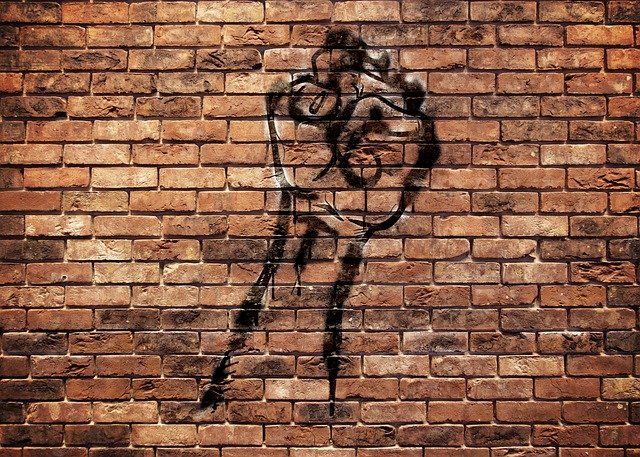
Copyright Pixabay
*All individuals and organizations receive 4 full days of pre-publication notice.
* Visible minority status is based on pictures and ethnicity information from the internet, which is not always correct.
* This is a 30 page article in Microsoft Word, mainly because of the pie charts.
If liberals wanted a window of opportunity to defeat Trump in 2020, they got their wish. George Floyd’s death galvanized a nation and allowed liberals to finally release their pent up anger. The results are...a bit murky. While the protests lasted for weeks (and months for others), it was simply kindling for the larger question. How to respond to racism in every level of society. What was once a sign of toxic masculinity in police culture has now spread to every aspect of life for visible minorities. From gardening as a visible minority to bird-watching to golfing, dining, banking...and such.
George Floyd's death breathed new life into the fading Black Lives Matter movement.
Too soon for puns?
You're a horrible person.
It's probably too soon. But all movements worth their salt have sacrificial lambs. Anti-racism, anti-sexism and LGBTQ movements will forever be scarred by the pain and death of those that came before them. It's how you react to that pain that will decide if progress occurs. Tell me, is progress made by rehashing the Atlantic slave trade every time a racist action appears? If so, I'm not seeing it.
But that hasn't stopped liberals from using it as ammunition. In 2020, the global public has been swamped with articles and videos about the historical past of slavery. Ideas and facts they can easily look up on their own (if they wanted to). But the specter of violent protests and blatant racism in police culture has forced liberals to prove their anti-racism support.
Some have put black squares on their social media accounts. Others are vandalizing racist monuments. Others are giving copious amounts of money to liberal non-profits. A few have created their own autonomous zones. And others have kneeled while shaming those who refused to do so.
While this is commendable, it's not even close to real empowerment. It's just liberals feeling good about themselves, upgrading their social credibility, and feeling that they were on the right side of history. Admirable, but pointless. Like, sexism, racism has existed for thousands of years. The idea that it would be wiped out after the 2020 protests is laughable. Any intelligent student of history would tell you that ideologies rise and fall in a circular motion.
Contrary to what you may think, there is no straight line of upward progress for humanity. The progress comes...and goes in waves. The intellect of the ancient Greeks...the fall of the Roman Empire. The Dark Ages...the Enlightenment Period. The Nazi holocaust...the rise of unfettered capitalism.
But I digress. My apologies. I tend to go weak in the knees as I philosophize about the evolution of ideologies throughout history. But then again, that's the problem we face today. Racism is an unfalsifiable ideology that will never die. All of the above "anti-racist" efforts are nothing more than tokenism in my opinion. Superficial window dressing. Yes, Michael Jordan's hundred million dollar donation is nice, but you can't buy your way out of racism. It doesn't work that way. Perhaps Hollywood can be of some help with the 2005 film V for Vendetta.
"Beneath this mask there is more than flesh. Beneath this mask there is an idea Mr. Creedy. And ideas are bulletproof."
Racism is an ideology. There's no amount of money that can stop, kill, or prevent racism. It's not a medical disease that can be "cut out" of society or "treated" in a person.
Fine, what do you suggest?
I suggest empowering visible minorities by training/grooming them to take over positions of power. If you feel guilty about your white privilege, empower visible minorities and then back the f*ck away. We don't need White people speaking for us. I don't need White journalists, politicians, CEOs or executives telling me how I should act. But even if they were visible minority speakers, I probably wouldn't listen anyways. Individualism vs. collectivism. I'm sure you can guess which one is more dominant in Western-European countries. Or more accurately, individualism is more dominant at the higher rungs of society as opposed to collectivism (religion and racial movements) at the bottom rungs.
But if liberals are hell-bent on bending backwards to show their "anti-racism," I'd like to help them. I want liberal organizations to empower visible minorities because they believe that it's the correct/ethical thing to do, not because of a knee jerk reaction to toxic masculinity in police culture.
And that's where the New York Times comes in. The NYT is the largest liberal platform on the planet. Even with all the chaos in the industry, the NYT far outshines Vice, Buzzfeed, and Mother Jones in terms of power and credibility.
And that's why I've targeted them.
For a long time (especially in 2020), the NYT has claimed that they firmly support empowering visible minorities in their diversity and inclusion reports. Fine. Let's put that claim to the test. And as you'll see, in terms of positions of power, their claims of empowerment are nothing more than hollow words.
2019: 2/12 visible minorities on NYT Board.
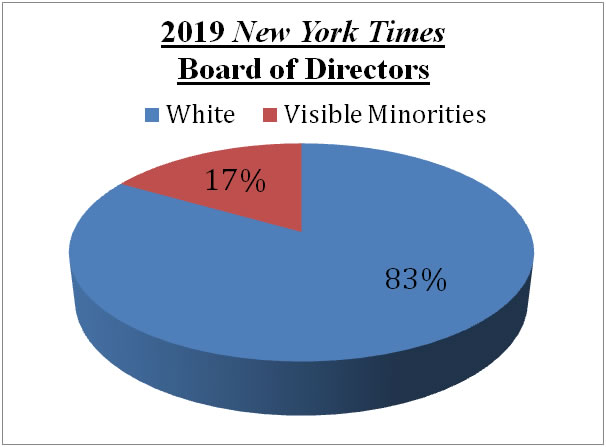
I would argue that 17% of visible minorities on a board is indicative of a racist institution. But maybe this is just a bad year for visible minorities on the NYT Board. So I took a look at the NYT Board from 2000-2018. And the results...speak for themselves.
2018: 3/14 visible minorities on the NYT Board.
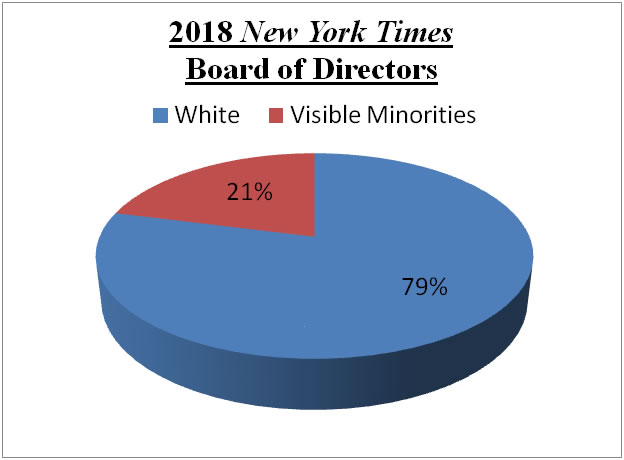
2017: 1/13 visible minorities on the NYT Board.
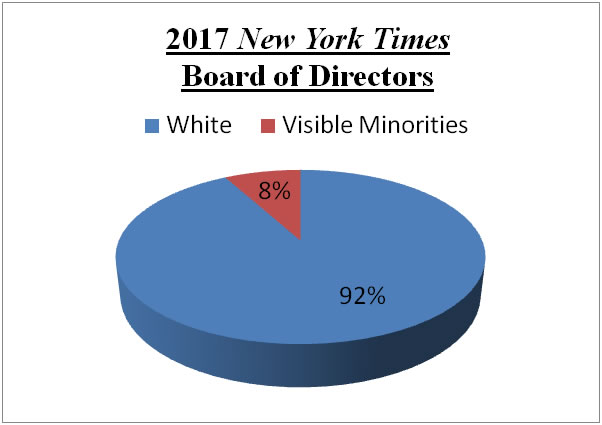
2016: 2/14 visible minorities on the NYT Board (but Dara Khosrowshahi could pass for White).
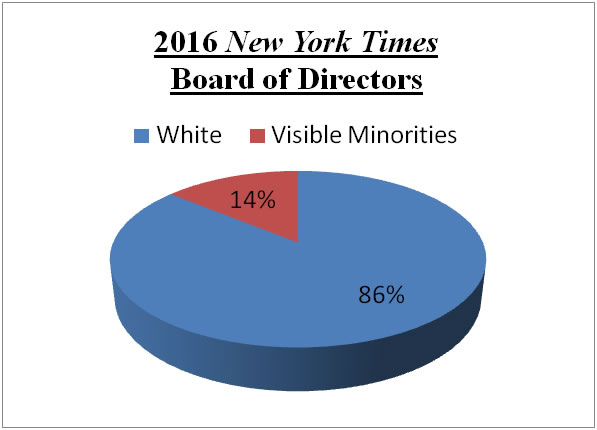
2015: 2/14 visible minorities on the NYT Board (but Dara Khosrowshahi could pass for White).
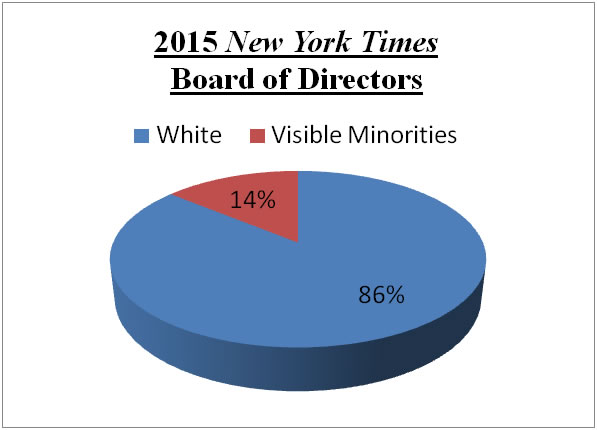
2014: 1/13 visible minorities on the NYT Board.
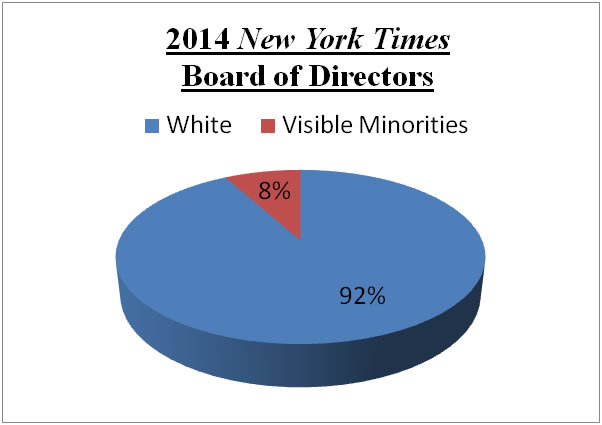
2013: 1/13 visible minorities on the NYT Board.
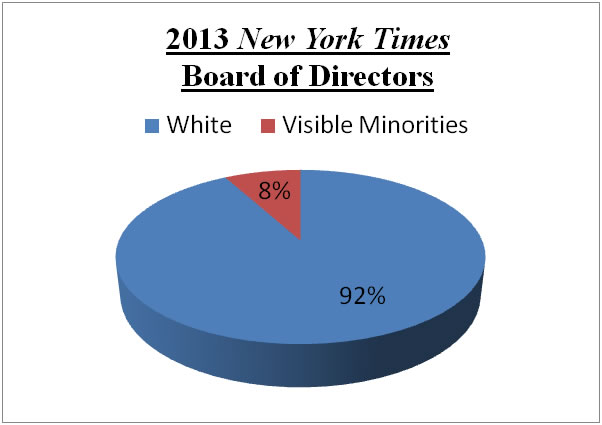
2012: 1/13 visible minorities on the NYT Board.
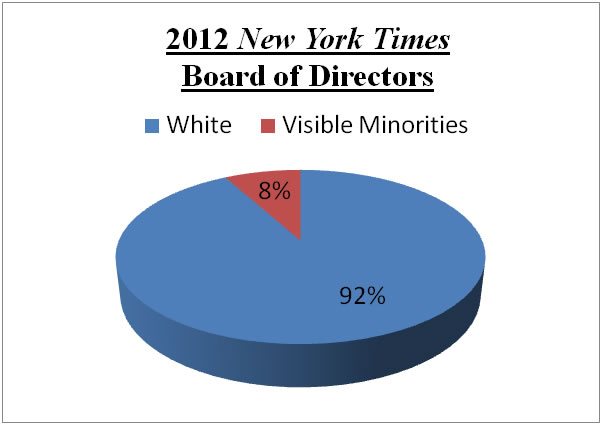
2011: 0/11 visible minorities on the NYT Board.
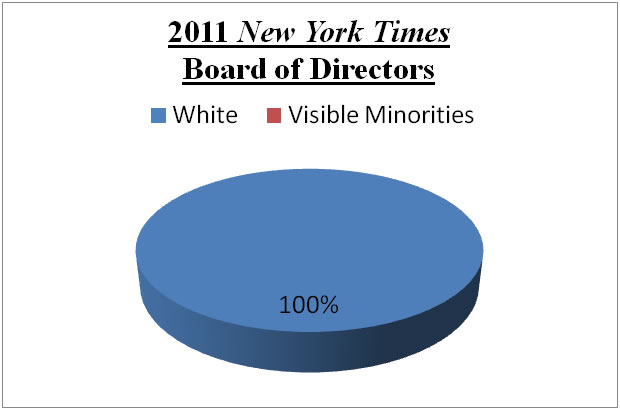
2010: 0/12 visible minorities on the NYT Board.
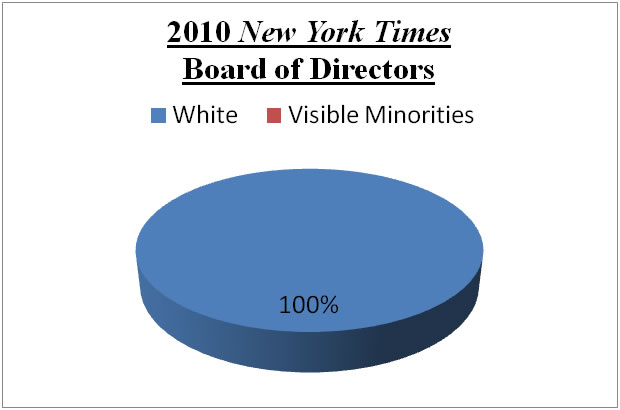
2009: 0/13 visible minorities on the NYT Board.
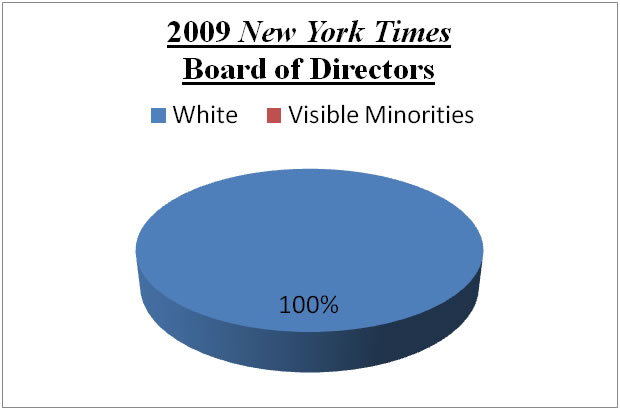
2008: 1/14 visible minorities on the NYT Board.
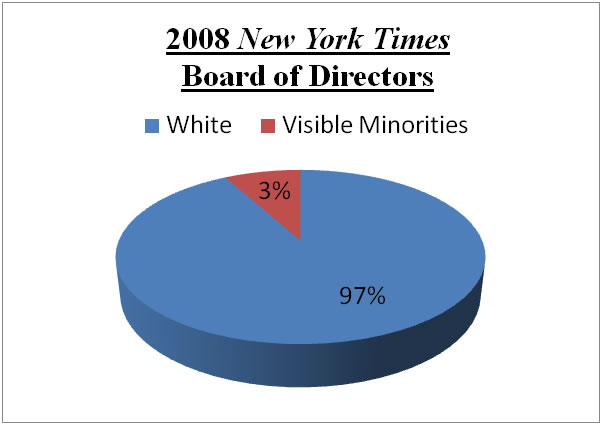
2007: 1/12 visible minorities on the NYT Board.
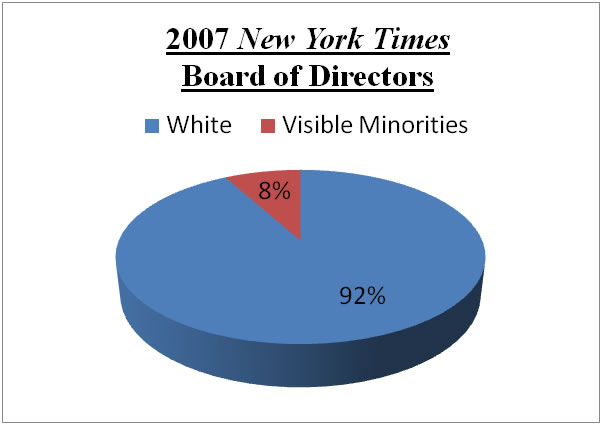
2006: 1/12 visible minorities on the NYT Board.
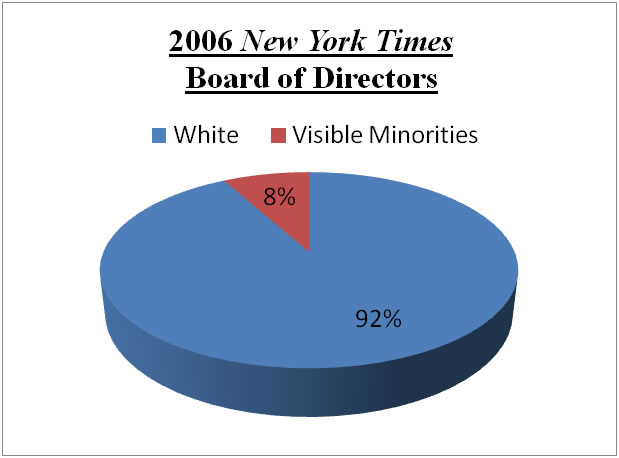
2005: 1/15 visible minorities on the NYT Board.
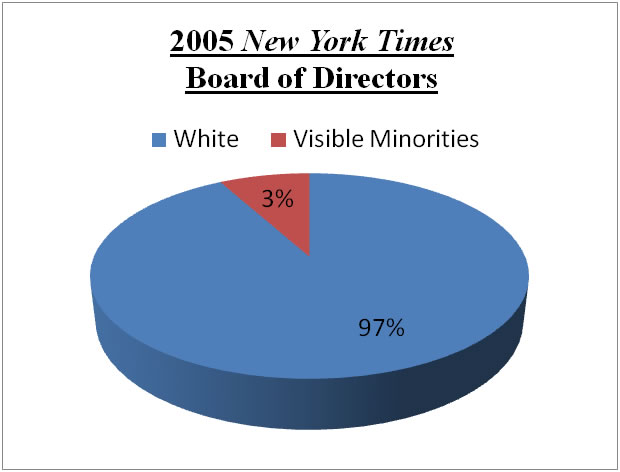
2004: 2/15 visible minorities on the NYT Board.
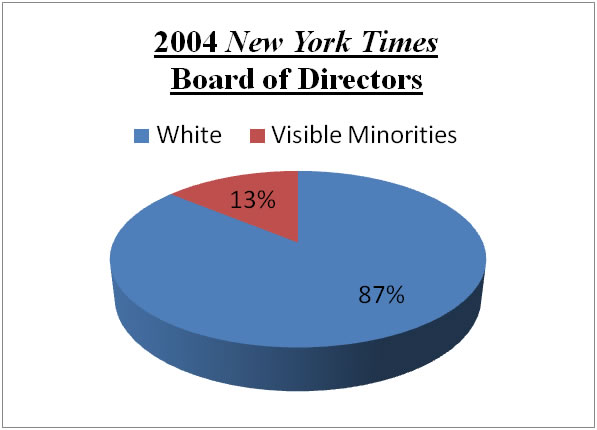
2003: 2/14 visible minorities on the NYT Board.
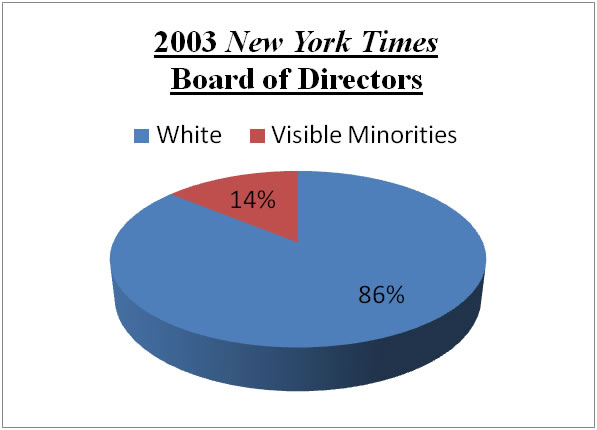
2002: 2/13 visible minorities on the NYT Board.
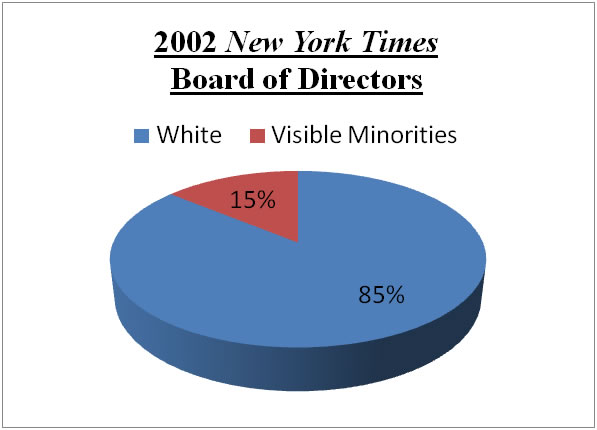
2001: 2/15 visible minorities on the NYT Board.
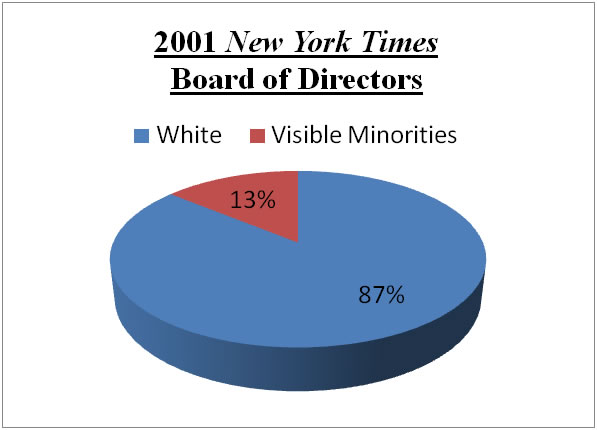
2000: 1/15 visible minorities on the NYT Board.
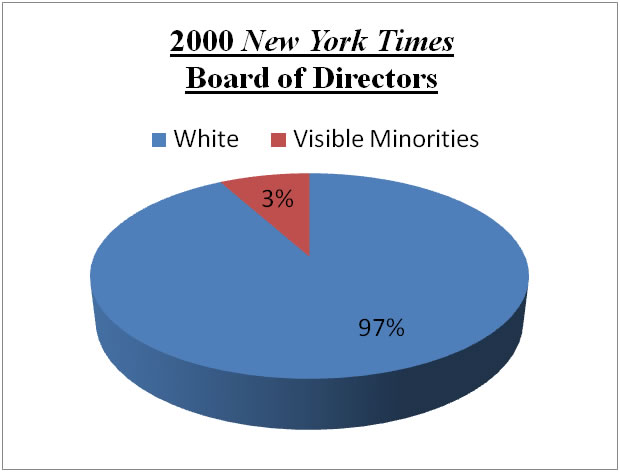
Just in case you missed it, the lowest percentage of visible minorities on the New York Times Board of Directors for the last 20 years is 0% and the highest is 21%. Sorry, but that’s racism to me. Why? Because it's tokenism. Tokenism is a reaction to racial discrimination laws. Since corporations can't legally discriminate based on race, they install a few token visible minorities at the top rungs to hide their racism. Window dressing. Unfortunately, I don't have access to the NYT annual reports before 2000 (but I wouldn't expect a major difference).
In a request for comment, I ask the NYT:
1. a) From 1969-1999, what is the highest number of visible minorities serving on the NYT Board of Directors in terms of percentage? For example, in 2019, there are 2/12 visible minorities on the Board, which equals 17%
1. b) Has the percentage of visible minorities on the board ever reached 50% in the last 50 years?
Their response:
"We are committed to having a diverse and inclusive organization - one that reflects the societies we report on with respect, empathy and accuracy. We release diversity stats for the company and our newsroom on an annual basis. You can find the annual reports here and our board of directors here."
I'm not a real journalist, but even I can tell this is a bulls*t response. The fact that the NYT spokesperson doesn't bother to answer any of the questions shows a lack of respect, which is ironic since the questions were about racism and came from a visible minority.
The purpose of this article is to question their supposed "commitment" to diversity. And from the past 20 years, nothing has really changed. The NYT has gone from 0-20% visible minority representation on the Board. That's not progress. That's tokenism. I believe that the NYT is intentionally suppressing visible minorities at the highest rungs while hiring them at the lowest rungs in order to fill their affirmative action (now called diversity) quotas.
Of course, others might have a different point of view.
The board of directors doesn't run anything. You can't say the company is racist.
On the contrary, a board of directors has final say on everything. As people should know from Hollywood, having the final say on an issue is the apex of power. A board creates the various policies that are representative of the company and instructs the CEO to implement it. Depending on the corporation, public shareholders have almost no say in policy. The most they can do is vote in and out a director. But the board can also vote people in an out. Generally speaking, most shares in a public company have no voting power. They're just common stock that makes money for the shareholder. Most of the voting is left to insiders, the directors themselves, or rich families/stakeholders.
But like many companies, the New York Times' share structure is special. While common stockholders get Class A shares, the real controlling interest is held by the Ochs-Sulzberger family and their Class B shares. It's possible that the Ochs-Sulzberger family is allegedly suppressing visible minority representation on the board and have been doing so for at least 20 years, most likely longer. The term "allegedly" is necessary in order to prevent defamation lawsuits.
Or simply put, White people are refusing to let visible minorities have equal say in a supposed "liberal" organization. I believe that such an action is deliberate, but I'm sure that the NYT will argue that it's not.
In a request for comment I ask:
2. a) Has the Ochs-Sulzberger family been suppressing visible minorities on the NYT board of directors for the last 50 years?
2. b) Does the NYT Board of Directors believe that 80% dominance of White people on the NYT Board (over 20 years) represents racism?
2. c) Does the NYT Editorial Board believe that 80% dominance of White people on the NYT Board of Directors (over 20 years) represents racism?
Their response:
"We are committed to having a diverse and inclusive organization - one that reflects the societies we report on with respect, empathy and accuracy. We release diversity stats for the company and our newsroom on an annual basis. You can find the annual reports here and our board of directors here."
The NYT spokesperson is downplaying the importance of my questions with their boilerplate response. Another reason why racism continues is because White people in power don't listen to visible minorities who aren't in power. The NYT can claim that they're "listening." But their response shows that they're not.
But moving onto the NYT Editorial Board (a group of NYT columnists), there are only 3 visible minorities on its 14 member board (though one could pass for White).
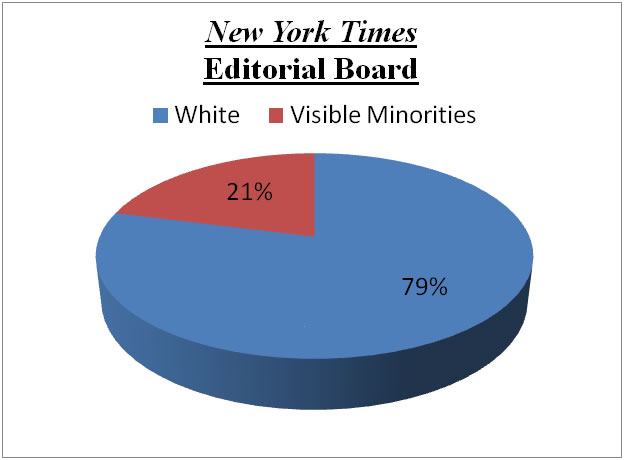
Right now, we have the NYT Board of Directors and the Editorial Board hovering at an average of 15-20% for visible minority representation. I wonder what the masthead pie chart would show. For those not in the know, a masthead is a list of people who make a significant contribution to a newspaper in a managerial sense. Usually executives and managing editors.
The total number of people on the NYT masthead is 23. Only 4 are visible minorities.
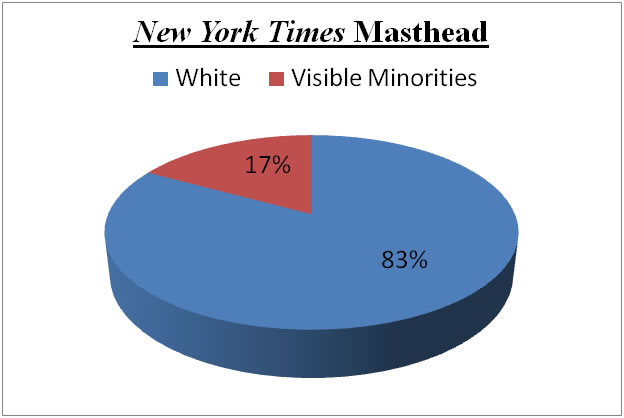
Even if you don't believe that a lack of visible minorities on the NYT Board of Directors constitutes racism, it's difficult to justify when the editors and executives who run the NYT on a daily basis are mainly White. But more so, the people on the masthead have power over visible minority journalists. Sure, there are lots of visible minorities working at the NYT, but only at the bottom rungs. I believe that such actions are intentional as opposed to accidental.
But I wonder what argument liberal reporters and managing editors from the NYT would give. In a request for comment I ask various NYT journalists and editors:
3. a) Do you believe that a lack of visible minorities at the highest rungs of a corporation represents racism?
3. b) Visible minorities comprise 21% of the NYT Editorial Board. They make up 17% of the names on the NYT masthead. And they make up 17% of the current NYT Board of Directors. Over the past 20 years, the NYT Board of Directors has reached a high of 21% and a low of 0% for visible minority representation. In your opinion, does this constitute racism? If not, why? If so, do you believe it's intentional or accidental?
I threw in the "accidental" term to see if they would take the bait. Contrary to what you may think, there's no such thing as "accidental" racism. Before the 2020 Black Lives Matter protests, liberals complained about racism, but when talking about it, they softened the wording to "prejudice," or an "unconscious bias." Of course they only use such words to describe other liberals. When it comes to conservatives, they go back to what they really want to say.
You're a racist if you support Trump.
If that's true, then 62 million Americans who voted for Trump in 2016 are all racists. Do you have a plan to deal with 62 million racists? Something different than all the past failures?
Like most philosophers, the problem lies in the definition. What constitutes racism? Is it believing that other people are inferior? What if you believe it and never act on it? Are you actions racist or simply disingenuous? What about cultural inappropriate names for sports teams? Is that racist? How about a White writer writing about visible minorities in a fictional book? What about a White actor voicing a visible minority in an animation? What about buying an All Lives Matter shirt? What about a White woman wearing cornrows? What about a company that employs mainly White people? What about a company that employs White people in 80% of its positions of power and has for decades? Is that racism?
Like all things, it depends on who you ask. Everyone has their own definition of what counts as racist and what doesn't. As an unfalsifiable ideology, the criterion for deciding what's what is vague and subject to change. But excluding or minimizing visible minorities at the highest rungs for at least 20 years counts as a racist action in my book. The idea that the NYT Board is "unaware" of their racist actions is a joke. But at the same time, most White NYT staff probably believes that they're empowering visible minorities by hiring them at the lowest rungs. But all I see are visible minorities working for their White masters. And with that colorful thought in your head, let's take a look at their responses.
For the third question, I sent request for comments to NYT journalists: Brent Staples, Jeneen Interlandi, Amy Harmon, Ross Douthat, Davey Alba, Michael Slackman, Sam Dolnick, Elizabeth Harris, and Ashley Southall. I would have sent more request for comments but to my surprise, there's no email icon for most NYT journalists. Years ago, I could have sworn that almost all NYT journalists had an email icon on their profile page. Today there are very few. For the ones that show it, you don't actually see the email address because the NYT blocks it. That's fine, but why do so many NYT journalists have no email icons? I could send a request for comment to the NYT spokesperson, but the response I got for my pre-publication questions annoyed me. And I don't have time to search the web or guess the email addresses of all NYT journalists.
And with that disappointment, let's get to their responses.
Unfortunately, none of them respond. 0/9. I believe that 4 days is enough pre-publication time for them to respond (if they wanted to). But racism, especially racism in your own company, is tough to talk about.
In the past, there's a reason why books were banned or burned. They were ideological carriers. Today, the internet serves that function. Something that the Chinese government understands very well. While racism is a powerful ideology, it can't operate without a user to believe it. But more so, it can't operate successfully without a network of people and institutions supporting it.
Liberals journalists who stay quiet or deny that a lack of visible minorities at the top rungs represents racism...are enabling racism. They're helping institutions propagate them by not taking action. You can go out and protest or write articles about racism all you want, but if you fail to call out racism in the workplace or in positions of power...you're not part of the solution. You're part of the problem.
In terms of money, one thing that all visible minorities (at the low and mid-income level) understand about their predicament is that wealth is a means of "lessening" the racism they face. It won't stop racism, but if you live in a high end neighborhood, the odds of being targeted by police officers and White people diminish greatly. Why? Because you have money. Because you're not draining the welfare system. Because your talents have been recognized by some industry in order for you to live in an upper crust neighborhood. Rich White people around you may not like it, but they'll sh*t the fuck up and make you believe that race doesn't matter.
And yes, I know the distinction between race and ethnicity. See Liberals Overdramatizing the Failure of Trump to Solve COVID and Racism in America.
But the reason why wealth matters for visible minorities is because it's capable of dulling the effects of racism in society. It won't end racism, but it can make it less visible to the naked eye. And in order to be wealthy or financial secure for life, we need White people to move the f*ck out of our way and make room for us. White people have had a 5000 year head start on us in terms of wealth and power. It's only fair to ask liberal organizations to make some space for us. But according to the data in this article, White people at the top rungs of the NYT have no interest in empowering visible minorities.
Personally, I'm not surprised. Liberals continue to claim that they've been empowering visible minorities for decades by employing them. But employing them at the bottom rungs is not empowerment. It's just another form of slave labor. Where others see empowerment, I see visible minorities serving their White masters.
Too crude?
Take a look at the owners/executives of NFL, NBA, and MLB teams. Take a look at the owners/executives of Silicon Valley companies. Take a look at owners/executives of Hollywood companies. Take a look at the number of visible minorities as tenured professors. Take a look at the governing bodies of universities. I dare the NYT to do a deep dive of these industries and show me equal representation of visible minorities at the highest rungs of power. I would bet a $1000.00 of monopoly money that they'll find that White people dominate to the tune of 80-90%. Why? Because the racism throughout North America isn't accidental, it's intentional. See The Conspiracy Against Visible Minorities.
You want to prove that you're anti-racist? That you're empowering visible minorities. That you're "liberal." Do a deep dive investigation into the board of directors/owners/executives of various liberal companies in the US, Canada, UK, and Europe and shame them for hiring mainly White people. The articles themselves won't have much power. But if visible minorities at the bottom rungs protest/quit their jobs because their companies are racist, that would send a bigger message to corporate America.
But I'm not going to write the deep dive series of articles. Why should I spend my time and effort proving that liberals are racist? I'm just a poor Guyanese-Canadian writer, philosopher, and conspiracy theorist trying to do my own thing.
I've gotten the ball rolling (at least in my mind). It's up to liberals to choose whether to roll the snowball into a giant boulder of shame and guilt and let it crash for everyone to see.






